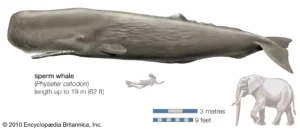14 dead sperm whales found beached on Australian island
#GS-03 Environment and Ecology
For Prelims
About Sperm Whales:
- Sperm whale, (Physeter catodon), also called cachalot is the largest of the toothed whales.
- It is the only living member of the genus Physeter and one of three extant species in the sperm whale family, with the pygmy sperm whale and dwarf sperm whale being the other two.
- They are named after the waxy substance “spermaceti” found in their heads.
- It has the largest brain on Earth, more than five times heavier than a human’s.
- Sperm Whales were hunted for spermaceti which is used in oil lamps, lubricants, and candles.
- They are found in temperate and tropical waters throughout the world.
- The species is protected by the International Whaling Commission moratorium.
- Ambergris, a solid waxy waste product sometimes present in its digestive system, is still highly valued as a fixative in perfumes.
IUCN Status: Vulnerable
CITES: Schedule 1
Wildlife Protection Act: Schedule 2

About Ambergris:
- Ambergris means grey amber in French.
- It is often incorrectly referred to as ‘whale vomit’.
- Experts across India estimate its value to be somewhere between Rs 1 to 2 crores per kilogram, depending on the purity and quality.
- Ancient Egyptians used it as incense. It is also believed to be used in some traditional medicines and as a spice.
- Ambergris contains alkaloids, acids, and a cholesterol like compound called ambreine.
- It floats around the surface of the water body and at times settles on the coast.




